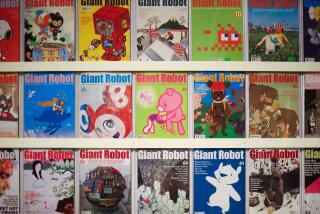Review: Sexual, comical, painful. A rare U.S. look at the radical art of Tatsumi Hijikata
The strip mall near the corner of Highland and Melrose avenues is so nondescript that you might miss it, even if you’re following your GPS to Nonaka-Hill gallery. You may feel even more lost when you pull into the parking lot and see a “Best Cleaners” sign over the gallery entrance.
Those sentiments multiply a thousandfold when you step into the darkened space. A pair of exhibitions catapults you through time and space to Tokyo in the late 1950s, ’60s and early ’70s.
That’s when Tatsumi Hijikata (1928-86) transformed modern Japanese dance into a kind of performance art so primal and poetic that it still resonates today. By turns beautiful and excruciating, comical and harrowing, butoh speaks across cultures by giving voice to anyone who has felt out of place in society. Existential dread, sexual repression and soul-crushing standardization form the backdrop of Hijikata’s art. So does French literature, particularly the dark avant-gardisme of Antonin Artaud, Georges Bataille and Jean Genet.
Like those intellectual malcontents, Hijikata believed that art had become too mannered, imitative and polite to be real. So he stripped dance to its raw essentials: convulsive movements and contorted gestures that captured the agony and absurdity of a nation clawing its way to prosperity after two of its major cities — and hundreds of thousands of its innocent citizens — were killed by U.S. nuclear bombs.
The two exhibitions fill three small spaces.
Organized by art historian Takashi Morishita and Butoh Laboratory, Japan, “Tatsumi Hijikata” consists of two rooms packed with archival materials borrowed from Keio University Art Center in Tokyo. The 40 artifacts include posters, props, theatrical backdrops, documentary photographs and scrapbook facsimiles. They sketch the context for three videotaped performances: “Revolt of the Body” (filmed by Hiroshi Nakamura in 1968), “A Story of Small Pox” (filmed by Keiya Ouchida in 1972) and “Tohoku Kabuki Project” (filmed at Hijikata’s studio, Asbestos Hall, in 1976).
In the 13-, 50- and 30-minute performances, alienation and its antidotes latch onto one another. A kind of punk opera unfolds, immersing visitors in a world where ritual and improvisation collide and commingle. Sex and violence burble just beneath the surface. Gender boundaries dissolve in a miasma of lust and frustration. Artifice is not rejected for its falsity so much as it is rejiggered into something far stranger: A framework in which anything might happen. Fatalism and freedom overlap and mutate.
The other exhibition, “Eikoh Hosoe: Collaborations With Tatsumi Hijikata,” occupies a bright space. It features “Navel and A-Bomb,” an unsettling 20-minute film Hosoe directed and shot in 1960, along with 21 of his gelatin silver prints. Each depicts one of the impromptu performances that the two artists staged in a farming village in the Japanese countryside, near Hijikata’s birthplace, in 1965 and 1968.
Hosoe’s exquisitely printed photographs are flippant and brilliant. They show Hijikata acting like a fool — or court jester — among hardworking farmers and their children, hamming it up not to make fun of their countrymen but to speak freely about the importance of feeling at home in the world, whether that means belonging to a community or just communicating with others, honestly and truly.
The photographs by Hosoe, 86, still do that today. So do Hijikata’s performances. Although neither artist’s works are based in the belief that art is timeless or transcendent, both invite a type of time travel that is anything but pedestrian.
Tatsumi Hijikata
Where: Nonaka-Hill, 720 N. Highland Ave., L.A.
When: Tuesdays-Saturdays, through Nov. 30
Info: (323) 450-9409, www.nonaka-hill.com
Please support our coverage of L.A.’s art scene. Consider a digital membership.
More to Read
The biggest entertainment stories
Get our big stories about Hollywood, film, television, music, arts, culture and more right in your inbox as soon as they publish.
You may occasionally receive promotional content from the Los Angeles Times.










